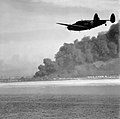File:Royal Air Force Coastal Command, 1939-1945. C1722.jpg
Appearance

Size of this preview: 605 × 600 pixels. Other resolutions: 242 × 240 pixels | 484 × 480 pixels | 774 × 768 pixels | 1,033 × 1,024 pixels | 2,400 × 2,380 pixels.
Original file (2,400 × 2,380 pixels, file size: 1.25 MB, MIME type: image/jpeg)
File history
Click on a date/time to view the file as it appeared at that time.
| Date/Time | Thumbnail | Dimensions | User | Comment | |
|---|---|---|---|---|---|
| current | 12:57, 4 October 2017 |  | 2,400 × 2,380 (1.25 MB) | Ducksoup | Resolution 776×800, replace with 2,400×2,380 |
| 12:33, 28 January 2014 |  | 776 × 800 (76 KB) | Fæ | {{User:{{subst:User:Fae/Fae}}/IWM |description = {{en|''Royal Air Force Coastal Command, 1939-1945.''<br/> A Lockheed Hudson of No. 220 Squadron RAF approaches Dunkirk on a reconnaissance patrol during the evacuation of the British Expeditionary Force... |
File usage
The following page uses this file:



